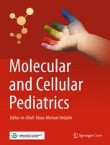Estimated prevalence of potentially damaging variants in the leptin gene
Mutations in the leptin gene (LEP) can alter the secretion or interaction of leptin with its receptor, leading to extreme early-onset obesity. The purpose of this work was to estimate the prevalence of heteroz...
